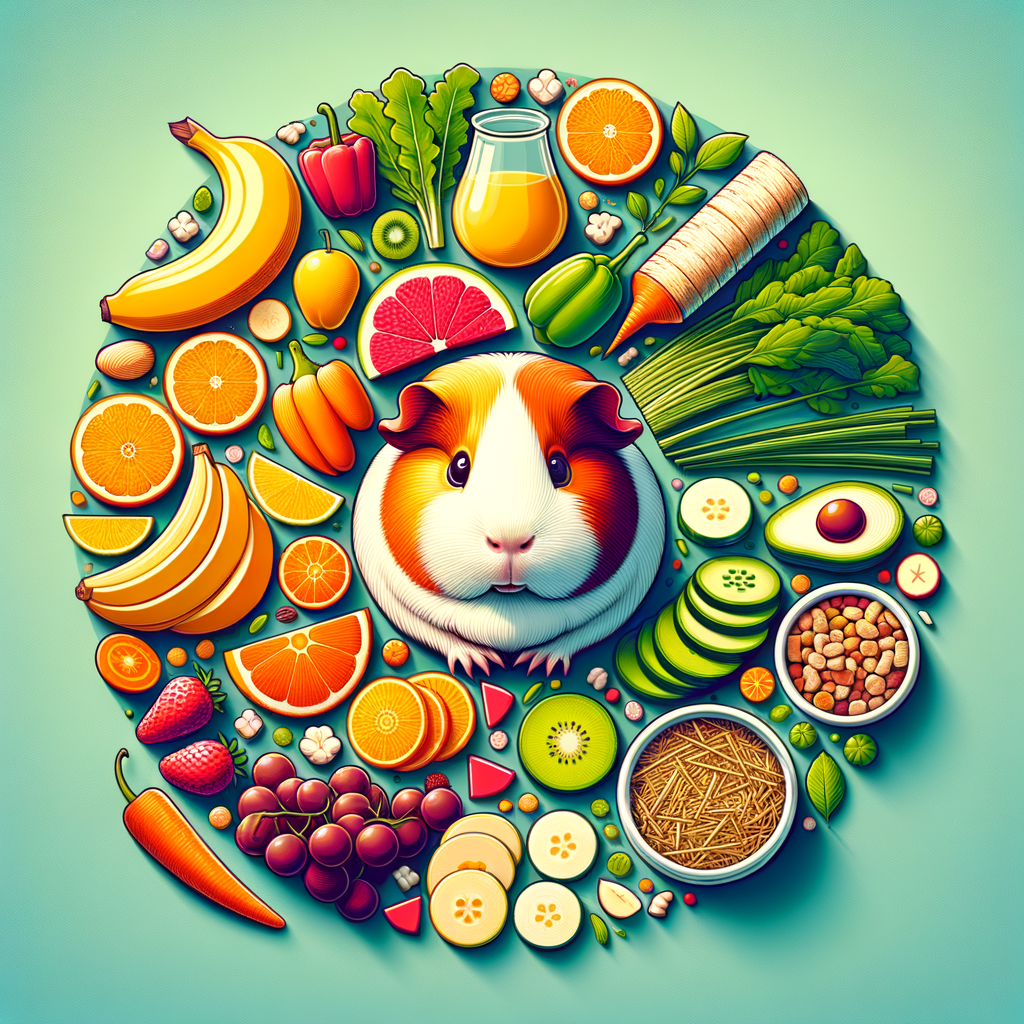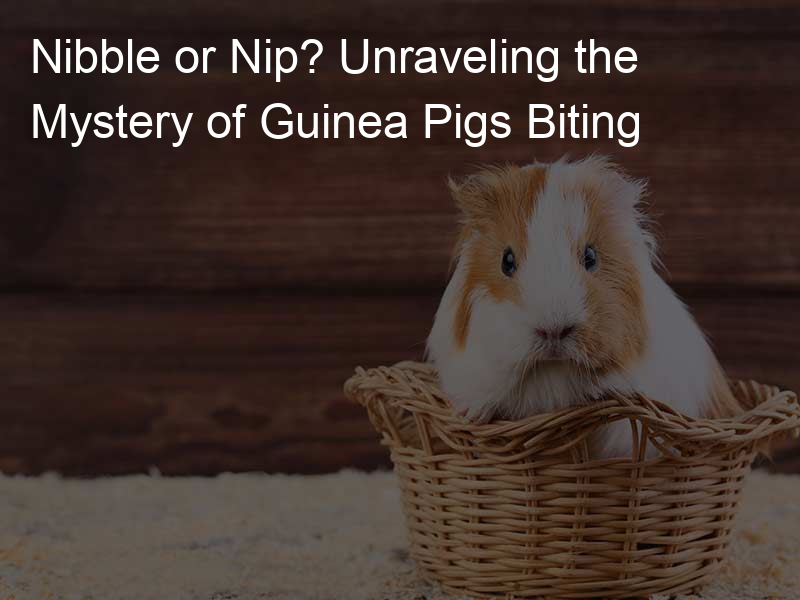
Introduction to Guinea Pig Diet
Understanding the dietary needs of your guinea pig and the importance of a balanced diet are key to ensuring their health and happiness. In this section, we will delve into these topics, providing you with the knowledge you need to make informed decisions about your pet’s nutrition.
- Understanding the dietary needs of Guinea Pigs
- Importance of a balanced diet for Guinea Pigs
Guinea pigs, like humans, are omnivores. This means they eat both plants and meat. However, their diet in the wild consists mainly of fresh hay, vegetables, and fruits. They also need a constant supply of fresh water. Guinea pigs cannot produce vitamin C on their own, so it’s crucial that this is included in their diet. Without it, they can develop a condition called scurvy, just like humans.
A balanced diet is essential for a guinea pig’s overall health. It helps maintain their weight, keeps their teeth in good condition, and supports a healthy digestive system. A diet that lacks in any essential nutrients can lead to health problems. For example, a lack of fiber can lead to digestive issues, while a lack of vitamin C can lead to scurvy. Therefore, it’s important to provide a variety of foods to meet all their nutritional needs.
In the following sections, we will explore in more detail what a guinea pig’s natural diet looks like, their favorite foods, the science behind their diet, best practices for feeding, how they choose what to eat, and a case study on implementing a healthy diet for a guinea pig. By the end of this article, you should have a comprehensive understanding of how to meet your guinea pig’s dietary needs.
What do Guinea Pigs Eat: A Look at Their Natural Diet
Understanding the natural diet of guinea pigs can help us provide the best nutrition for our domesticated friends. Let’s explore what guinea pigs eat in the wild and how domestication has changed their diet.
- Guinea Pigs in the wild: What do they eat?
- How domestication has changed the Guinea Pig diet
In their natural habitat, guinea pigs are primarily herbivores. They feed on a variety of vegetation, including grasses, leaves, and fruits. They also consume a significant amount of fiber, which is essential for their digestive health. In the wild, guinea pigs spend several hours each day foraging for food, which also contributes to their physical health and well-being.
Domestication has significantly altered the diet of guinea pigs. While they still require a high-fiber diet, most of their nutrition now comes from specially formulated guinea pig pellets, fresh fruits, and vegetables. However, it’s important to remember that not all fruits and vegetables are safe for guinea pigs. For instance, some types of lettuce can cause digestive issues, while others, like bell peppers and cucumbers, are beneficial for their health.
It’s also worth noting that domesticated guinea pigs need a regular supply of Vitamin C, as they cannot produce it themselves. In the wild, they would get this from various fruits and vegetables, but in a domestic setting, it often needs to be supplemented.
In conclusion, while the diet of domesticated guinea pigs has changed from their wild counterparts, the core principles remain the same. They need a diet high in fiber, with a variety of fruits and vegetables, and a regular supply of Vitamin C. By understanding their natural diet, we can ensure we are providing the best possible nutrition for our furry friends.
Favourite Guinea Pig Foods: What They Love to Munch On
Guinea pigs, also known as cavies, are herbivores with a unique and varied diet. They love to munch on a variety of foods, and providing them with a balanced diet is crucial for their health and happiness. Let’s explore the top five favourite foods of guinea pigs and understand why they love these foods.
- Top 5 favorite foods of Guinea Pigs
- Hay: This is a staple in a guinea pig’s diet and they absolutely love it. It helps in digestion and provides the necessary fiber.
- Carrots: Guinea pigs love the sweet taste of carrots. They are also a great source of Vitamin A.
- Peppers: Bell peppers are a favourite because they are high in Vitamin C, which guinea pigs need in their diet.
- Cucumbers: These are a refreshing treat for guinea pigs, especially during the summer.
- Parsley: This herb is loved by guinea pigs for its unique taste and it also provides them with Vitamin C.
- Why Guinea Pigs love these foods
Guinea pigs have a few favourite foods that they simply can’t resist. Here are the top five:
Guinea pigs are attracted to foods that are high in nutrients, especially Vitamin C, as they cannot produce this vitamin on their own. They also love foods that are sweet or have a unique taste. The texture of the food also plays a part in their preference. For example, the crunchiness of carrots and peppers is something that guinea pigs enjoy.
Providing a variety of these favourite foods will not only keep your guinea pig happy but also ensure they are getting a balanced diet. Remember, a healthy guinea pig is a happy guinea pig!
Guinea Pig Nutrition: The Science Behind Their Diet
Understanding the nutritional needs of your guinea pig is crucial to ensuring their health and longevity. Let’s delve into the science behind their diet.
Understanding Guinea Pig Nutritional Needs
Guinea pigs, like us humans, require a balanced diet to thrive. This means they need a variety of nutrients in the right proportions. Let’s explore the essential nutrients for guinea pigs and their roles in maintaining good health.
- Essential nutrients for Guinea Pigs
Guinea pigs require a mix of vitamins, minerals, proteins, carbohydrates, and fats. Here are some of the most important ones:
| Nutrient | Importance |
|---|---|
| Vitamin C | Guinea pigs cannot produce their own vitamin C, making it a crucial part of their diet. It aids in growth, healing, and a healthy immune system. |
| Protein | Protein is vital for growth and repair in guinea pigs, especially for young, growing ones. |
| Fiber | Fiber helps maintain a healthy digestive system and is a must-have in a guinea pig’s diet. |
- Role of these nutrients in Guinea Pig health
Each nutrient plays a unique role in the health of a guinea pig. For instance, Vitamin C prevents scurvy, a disease that can cause lethargy, weight loss, and bleeding. Protein supports growth and repair, especially in young guinea pigs. Fiber, on the other hand, aids digestion and helps prevent obesity and dental problems.
Understanding these nutritional needs is the first step towards providing your guinea pig with a diet that will keep them happy and healthy. In the next section, we’ll explore the best foods to meet these needs.
Healthy Foods for Guinea Pigs: Meeting Their Nutritional Needs
Guinea pigs are adorable, small pets that bring joy and happiness to their owners. However, to keep them healthy and active, it’s crucial to provide them with the right diet. Let’s delve into the best foods that can meet their nutritional needs.
- Best Foods for Providing Essential Nutrients
Guinea pigs require a variety of nutrients for optimal health. Here are some foods that are rich in these essential nutrients:
| Food | Nutrient |
|---|---|
| Hay | Fiber |
| Dark leafy greens | Vitamin C, Vitamin A |
| Carrots | Vitamin A, Fiber |
| Peppers | Vitamin C |
| Guinea pig pellets | Protein, Fiber, Vitamin C |
Remember, fresh water should always be available for your guinea pig. It’s a vital part of their diet too!
- How to Incorporate These Foods into the Guinea Pig Menu
Now that we know the best foods for our guinea pigs, the next step is to incorporate them into their daily menu. Here’s how:
- Hay: Make sure hay is always available for your guinea pig. It should make up about 70% of their diet.
- Vegetables: Serve a cup of fresh vegetables daily. Mix different types to provide a variety of nutrients.
- Fruits: Fruits are high in sugar, so they should be given sparingly, as a treat. A small slice of apple or a few blueberries are enough.
- Pellets: Provide a small amount of guinea pig pellets daily. Choose a brand that is high in fiber and vitamin C.
Remember, each guinea pig is unique and might have different dietary preferences. Monitor your pet’s eating habits and adjust the diet as needed. A healthy diet is the key to a happy and active guinea pig!
Feeding Guinea Pigs: Best Practices
Feeding your guinea pig properly is crucial for their health and happiness. In this section, we will discuss how often to feed your guinea pig and the appropriate portion sizes and feeding times. Let’s dive in!
- How often to feed Guinea Pigs
- Portion sizes and feeding times
Guinea pigs need to eat regularly to stay healthy. It’s best to feed them twice a day – once in the morning and once in the evening. This schedule mimics their natural eating habits in the wild. Remember, fresh water should always be available for your guinea pig.
Portion sizes depend on the type of food you’re feeding your guinea pig. For fresh vegetables, a cup per day is a good measure. For pellets, follow the instructions on the package, but a general rule is an eighth of a cup per day. As for hay, which should make up the majority of their diet, make sure it’s always available for them to nibble on throughout the day.
Feeding your guinea pig is not just about quantity, but also quality. Make sure you’re providing a balanced diet that includes a variety of foods. This will ensure they get all the nutrients they need to stay healthy.
Remember, every guinea pig is unique. Monitor your pet’s eating habits and adjust the feeding schedule and portion sizes as needed. If you notice any changes in their appetite or weight, consult a vet.
Feeding your guinea pig properly is one of the best ways to show them love and care. By following these best practices, you can ensure your furry friend stays happy and healthy.
Guinea Pig Food Preferences: How They Choose What to Eat
Guinea pigs are known for their unique food preferences. They have a keen sense of taste and can be quite picky about what they eat. Understanding their food preferences can help you provide a balanced and nutritious diet for your pet.
- How Guinea Pigs show preference for certain foods
- What these preferences mean for their diet
Guinea pigs show their food preferences in various ways. They may sniff and nibble at a new food before deciding whether to eat it or not. If they like it, they will eat it eagerly and quickly. If they don’t, they may push it aside or ignore it completely. Some guinea pigs may even squeak or purr when they see their favorite foods, showing their excitement and anticipation.
Guinea pigs also have a strong preference for fresh foods. They love crunchy vegetables and fruits, especially those with a high water content. This is likely because these foods resemble the fresh plants they would eat in the wild.
The food preferences of guinea pigs have important implications for their diet. Since they prefer fresh foods, it’s important to provide a variety of fresh fruits and vegetables in their diet. However, not all fruits and vegetables are safe for guinea pigs, so it’s important to do your research before introducing a new food.
Guinea pigs also need a steady supply of hay, which helps with digestion and dental health. Even though they may not show as much excitement for hay as they do for fresh foods, it’s a crucial part of their diet.
Lastly, guinea pigs cannot produce vitamin C on their own, so they need to get it from their diet. This is why they love fruits and vegetables that are high in vitamin C, like bell peppers and oranges. However, too much vitamin C can be harmful, so it’s important to balance their diet carefully.
In conclusion, understanding your guinea pig’s food preferences can help you provide a diet that is not only tasty but also nutritious. Remember to always introduce new foods slowly and monitor your guinea pig’s reaction to ensure they are enjoying their meals and staying healthy.
Case Study: Implementing a Healthy Diet for My Guinea Pig
As a guinea pig owner, it’s important to understand the dietary needs of our furry friends. In this section, I will share my personal experience of changing my guinea pig’s diet and the key takeaways from this case study.
- Personal experience with changing a Guinea Pig’s diet
When I first brought my guinea pig, Fluffy, home, I was feeding her a diet primarily composed of guinea pig pellets. However, after doing some research, I realized that Fluffy’s diet was lacking in essential nutrients. I decided to make a change.
I began by introducing fresh fruits and vegetables into Fluffy’s diet. I also made sure to include a variety of leafy greens, which are rich in Vitamin C, a nutrient that guinea pigs cannot produce on their own. I also reduced the amount of pellets and introduced more hay, which is essential for their digestive health.
The transition was not easy. Fluffy was initially resistant to the new foods, but with patience and persistence, she eventually started to enjoy her new diet.
- Results and key takeaways from the case study
After a few weeks of implementing the new diet, I noticed significant changes in Fluffy. Her fur became shinier, she was more active, and her overall health improved. I also noticed that she was more excited during feeding times, eagerly awaiting her fresh fruits and vegetables.
From this experience, I learned that a balanced diet is crucial for a guinea pig’s health. While pellets can be a part of their diet, they should not be the main component. Fresh fruits, vegetables, and a good amount of hay should make up the majority of a guinea pig’s diet.
Another key takeaway is the importance of patience when introducing new foods to your guinea pig. They may be resistant at first, but with time, they will adapt to the new diet.
In conclusion, a healthy diet is key to a happy and healthy guinea pig. As owners, it’s our responsibility to ensure that our pets are getting the nutrients they need. Remember, a well-fed guinea pig is a happy guinea pig!
Conclusion: Ensuring Your Guinea Pig’s Dietary Needs Are Met
As we wrap up this comprehensive guide on guinea pig nutrition, it’s essential to remember that a balanced diet is the cornerstone of your pet’s health and happiness. Let’s recap the key points and share some final tips to ensure your guinea pig’s dietary needs are met.
- Recap of the importance of a balanced Guinea Pig diet
Feeding your guinea pig a balanced diet is not just about keeping them full. It’s about providing them with the necessary nutrients for their growth, development, and overall well-being. A diet rich in vitamin C, fiber, and low in fat is crucial for their health.
Remember, guinea pigs are herbivores, and their diet should primarily consist of hay, fresh vegetables, and a small portion of specially formulated guinea pig pellets. Treats should be given sparingly and should never make up a significant portion of their diet.
Also, it’s important to note that not all foods are safe for guinea pigs. Some foods, like onions, garlic, and certain types of fruits, can be harmful to them. Always research before introducing a new food item into their diet.
- Final tips for feeding Guinea Pigs
When it comes to feeding your guinea pig, consistency is key. Establish a feeding routine and stick to it. This not only helps in digestion but also gives your pet a sense of security.
Always provide fresh water for your guinea pig and change it daily. Water is an essential part of their diet and should never be overlooked.
Monitor your guinea pig’s eating habits and weight regularly. Any sudden changes could be a sign of illness and should be addressed immediately.
Lastly, remember that every guinea pig is unique. What works for one may not work for another. It’s important to understand your guinea pig’s preferences and dietary needs. If you’re ever in doubt, consult with a vet or a guinea pig nutrition expert.
In conclusion, a balanced diet is the key to a healthy, happy guinea pig. By understanding their dietary needs and feeding them accordingly, you can ensure your furry friend lives a long, fulfilling life.







